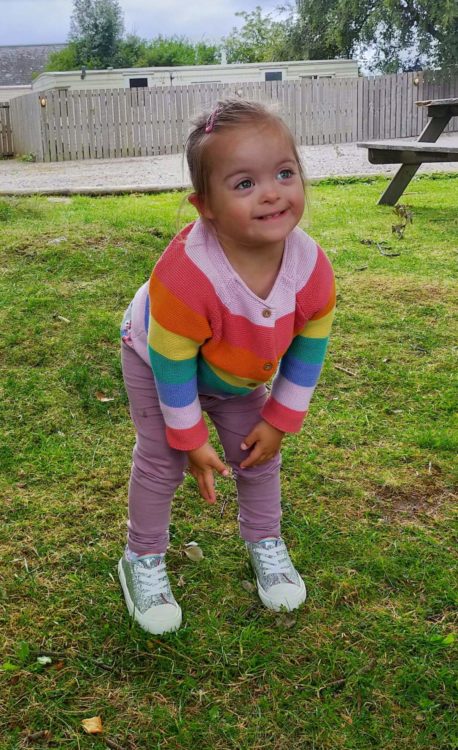I chose to read “Sisters of Arden” by Judith Arnopp, as I heard it contained a character with Down syndrome. As the mother of a little girl with Down syndrome, I have an interest in how people with my daughter’s condition are portrayed in literature. The novel was published in 2018, but I have only just found the time to read it now, as toddlers do tend to keep you busy! What I found in Judith Arnopp’s writing shocked me, and at one point, reduced me to tears. I’m unsure where Arnopp has gathered her information about Down syndrome, but her work shows a clear and abhorrent prejudice against people with the condition.
Arnopp has created the character of Sister Frances, who has Down syndrome. We are introduced to her in the most diabolical manner. Arnopp writes, “Sister Frances isn’t given to words. She is slow in both thought and action; Sister Dorothea swears she must have been dropped on her head as an infant.” Do I even need to explain why this description of a character is unacceptable? It is an antiquated and derogatory stereotype of people with Down syndrome, suggesting that people with the condition are somehow damaged. Or that there is something vastly wrong with a person with a learning disability. The suggestion that we should laugh wryly at Sister Dorothea’s suggestion is derogatory in nature and immediately reduces Sister Frances to a caricature.
Slightly further along in the novel, we come to a sentence in which Arnopp describes Sister Frances as “a simpleton.” The definition of simpleton is “someone who is not very intelligent.” Down syndrome is classed as a learning disability/intellectual disability, meaning that it can take people with the condition longer to learn skills. And there is nothing wrong with that. Who made these rules that there is a timescale and a deadline in which we should be able to butter our toast or boil an egg? And if you don’t hit your deadline, you’re in trouble! Getting back to the point though, using the word “simpleton” to describe a character with Down syndrome is downright offensive. Arnopp builds on the prejudiced image of her character by using the word “simple” repeatedly to describe Sister Frances throughout the novel.
Arnopp also uses infantilization to depict Sister Frances. She portrays her as childlike, as needing to be cared for, and alongside that she weaves into her writing the idea that Sister Frances is irritating. She even goes so far as to have one of the other characters state that she was “grating on my nerves.” In another scene, this character, her caregiver states she is now ignoring Sister Frances. The overall impression created by Arnopp is that this woman is a nuisance to those around her and needs to be excluded by ignoring her.
Arnopp uses a variety of literary techniques to further persuade the reader of her perception of Down syndrome. One particularly shocking line reads that Sister Frances is “lumbering behind them like a performing bear.” The use of the adjective “lumbering” creates a disrespectful image of how the character walks, but it is the use of the comparison of Sister Frances to a “performing bear” that is the most shocking. Using the technique of dehumanization, Arnopp reduces Sister Frances’ status to that of an animal. And not just an animal. A performing bear is a captive animal, usually held in chains in order to dance in a comical manner for the entertainment of others. The simile Arnopp has chosen to use further impresses upon the reader that the character with Down syndrome is not equal to her counterparts. That she is an animal to be laughed at.
Arnopp encourages her readers to mock and laugh at Sister Frances by repeatedly describing her as not being able to sing very well. She “joyfully joins her discordant notes with the others.” This perpetuation of guiding the reader to laugh at this character is tiresome to endure. It justifies to the reader that the author believes it is acceptable to laugh at people with Down syndrome. It is abhorrent, especially as the mother of a little girl with Down syndrome.

Arnopp furthers her impression of Sister Frances as a hindrance to others by describing the way she moves in a clumsy manner. Instead of describing her as walking, like the others, she describes Sister Frances as “stumbling.” This description speaks volumes about the way Arnopp perceives people with Down syndrome move. She writes that Sister Frances was “treading on people’s toes and causing uproar.” This cheap attempt at humor is at the cost of people with Down syndrome. Suggesting that people should laugh at the way others who have hypotonia move is inciting behavior that belittles and bullies.
The constant references to Sister Frances being different from the other characters are sickening to read. Arnopp describes the character as having “strange, almond-shaped eyes” which highlights exactly how Arnopp perceives people with Down syndrome. At one point, the author states the following: “No house would take her; her difficulties make her strange, people may find her off-putting.” This idea that nobody would want a person with Down syndrome to live with them spins a whole new and worrying avenue of prejudice for the reader. This is followed, later on in the novel by the statement “my mistaken conviction that simple folk can make a difference.” Influencing the reader to think that people with Down syndrome are not welcome in the world is truly biased writing.
This is further compounded by the scenes in which Sister Frances is beaten and abused as a result of her being “an idiot.” Hate crime against people with learning disabilities is at its highest-ever level in the U.K. Normalizing a character being physically assaulted as a result of having a learning disability is irresponsible in light of the current levels of hate crime in our society.
If this novel had actually been written hundreds of years ago, I could perhaps understand why such antiquated perceptions of Down syndrome were being peddled as entertainment. Yet, the novel was published in 2018. Perpetuating this prejudiced view of people with Down syndrome is unacceptable, irresponsible and dangerous. As an author, Arnopp should know that her writing influences anyone who reads it and she should perhaps reflect on how she is influencing the readers of this novel to buy into her own biased view of Down syndrome. Having a platform to reach the masses comes with responsibility. When you use that power you have to create further bias, prejudice and discrimination against a minority community, there has to be some form of accountability.
In terms of how Arnopp’s decision to create a derogatory caricature of a woman with Down syndrome sits with me in modern society, it raises a number of grave concerns. The author has been allowed to use extremely derogatory words to describe a person with Down syndrome by her publisher. She was given a platform to spin these prejudiced pictures of a woman with a learning disability. This says to me that more people in the literary world than just Arnopp feel that it is acceptable to create such prejudice against people with Down syndrome. This is something that needs to change.
The Black Lives Matter movement has highlighted to us all how dangerous and unacceptable it is to have racist depictions of characters in entertainment still being used today. And it is right that these examples are being banned and removed from our culture. This issue of prejudice against people with learning disabilities being portrayed in historical fiction needs to be held with just as much weight. Let us not perpetuate the myth of prejudice.

